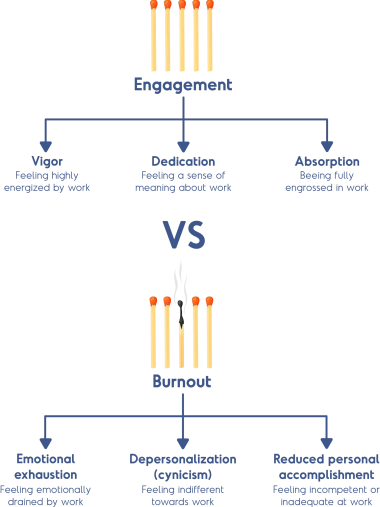Did you know? Working in the game industry isn’t always fun and games. The people behind the games also have the same struggles as employees in other industries, including burnout. Burnout can stem from various sources, including job stress, lack of stability, and long working hours. Let’s delve deeper into this topic!
What is Burnout?
Burnout is a condition that arises from unmanaged stress in the workplace, affecting both employees and employers alike. When experiencing burnout, you may experience fatigue, negativity, and a decrease in job performance. You might feel physically, mentally, and emotionally exhausted. Plus, negativity might make you feel indifferent toward your work. Burnout can also lead to decreased productivity and feelings of inadequacy when you might feel like you’re not accomplishing as much as you want to.

What Factors Contribute to Burnout?
Burnout is a common thing that can happen in all industries. But what are the causes? You might want to remember these major factors that can contribute to burnout! Here they are:
- Unfair Treatment at Work
- Unmanageable Workload
- Lack of Role Clarity
- Insufficient Communication and Guidance from Leaders
- Unrealistic Deadlines
In the game industry itself, burnout isn’t limited to only big console game studios. Burnout can happen in any part of the game industry, from large studios to indie developers. One of the contributors is “crunch time,” which refers to extended work hours, often surpassing 40 hours a week, over a prolonged period. At Agate, while crunch time may occur, we have implemented preventive measures, which will be discussed later in this article.
What are the Signs of Burnout?
Insomnia
Research indicates that prolonged stress impacts the delicate balance of the neurological and hormonal systems responsible for regulating sleep. So, when you’re not sleeping well, it can make feelings of burnout worse. Difficulty sleeping at night may be a warning sign of burnout.
Physical exhaustion
Feeling wiped out all the time is another big sign of burnout. It can be a common sign of burnout if you need to nap every day after work.
Changes in eating habits
Changes in eating habits, such as eating more or less than usual, can also indicate burnout. This can happen when you’re too busy or stressed to eat or crave more food. Stress hormones can also play a role, making you less hungry when you’re stressed and super hungry when the stress goes away.
Headaches and stomachaches
It is noteworthy that burnout can occur simultaneously with mental health conditions such as depression or anxiety, which may also lead to physical symptoms. Depression can make your muscles ache, give you stomachaches, mess with your sleep and change your appetite. Anxiety can give you headaches, make you feel sick to your stomach, and make it hard to catch your breath.
How to Deal with Burnout?
Contact professional help
If you’re dealing with physical symptoms of burnout, it’s a good idea to check in with your regular doctor or a mental health professional to determine if it’s from stress or something else.
Address the root of the problem
It’s important to address the root of your problems. For example, burnout usually comes from work-related stuff. However, chronic stress can have various causes, such as financial and relationship problems. It’s important to take a step back and figure out what’s going on so you can find a way to fix it.
Request better working conditions
If your working condition contributes to your burnout, it’s important to address the issue by speaking with your leaders or HR team. In Agate, we offer various resources to promote a positive work atmosphere, such as free coffee and designated quiet spaces for employees to recharge and focus. Other than the various resources, leaders in Agate are also very open to discussing the working conditions. Also, there are Talent Relation functions that are ready to listen and solve our crews’ burnout issues.
Ensure you have some freedom and autonomy in your job
When coping with burnout, it’s important to maintain a sense of control in your work. This can include having the ability to prioritize tasks and decide which ones to tackle first, whether it’s starting with the most challenging or easiest tasks based on your preference. Having control over your job can greatly help in managing burnout.
Try to make time to do what you love
Concentrating on work for extended periods can be draining. That’s why taking a break and engaging in activities you enjoy are essential. It can be as simple as watching your favorite movies or spending time with your closest ones.
How We Identify and Address Our Crews Burnout
Burnout can have multiple causes, but it’s often the result of systemic imbalances within an organization. That’s why Agate conducts a monthly well-being and burnout checkup to determine what systemic change we need to adjust to create a better work environment for everyone. Here’s how we do it:

Gather
It’s important to recognize that our employees may be experiencing increased workload and emotional stress outside of work, which can contribute to burnout. That’s why we gather data about our crews’ problems and issues through monthly well-being checkups.

Address
The data we gather will be analyzed to determine if the issues fall under professional well-being, such as workload, rewards, and benefits, or general well-being, such as team dynamics and company policies. Only by having a clear understanding of our workplace, team, and behaviors can we make meaningful changes to improve the well-being of our employees.

Solve
With the data, we take steps to make adjustments such as managing workload, implementing new procedures, offering rewards, etc. We also provide opportunities for learning, team bonding, and events to improve the overall well-being of our employees.
Talent’s Insight

What made Agate aware of burnout?
“We spend at least 1/3 of our weekdays at work interacting with each other. Many things such as issues, decisions, and discussions, can happen during the day. The interaction and daily work definitely affect crew well-being, including burnout levels.”
What drove Agate to create a well-being program?
“At the end of 2019, when there was a big decision that had an impact on the condition of some crews who looked unmotivated, lethargic, and started to complain, we realized that crew well-being is a shared responsibility, starting from the crew themselves, leadership, management, and the Talent team. So, the Talent team created a well-being program, starting with a psychometric-based survey which will be followed up and resolved immediately. This program is conducted every month for a quick checkup and every six months for a comprehensive survey. For cases that professionals can only handle, we also provide a list of psychologists and psychiatrists and make the crew aware that mental health is as important as physical health.”
What impact does the program have on crews?
“This program becomes an official medium for the crew to pour out their hearts; everything written is confidential but can still be followed up and handled accordingly. The most visible impact is that the crew feels heard, and the issues faced by the crew can be resolved together more quickly.”
Interested to be a part of our crews? Check out the vacancy list below!







